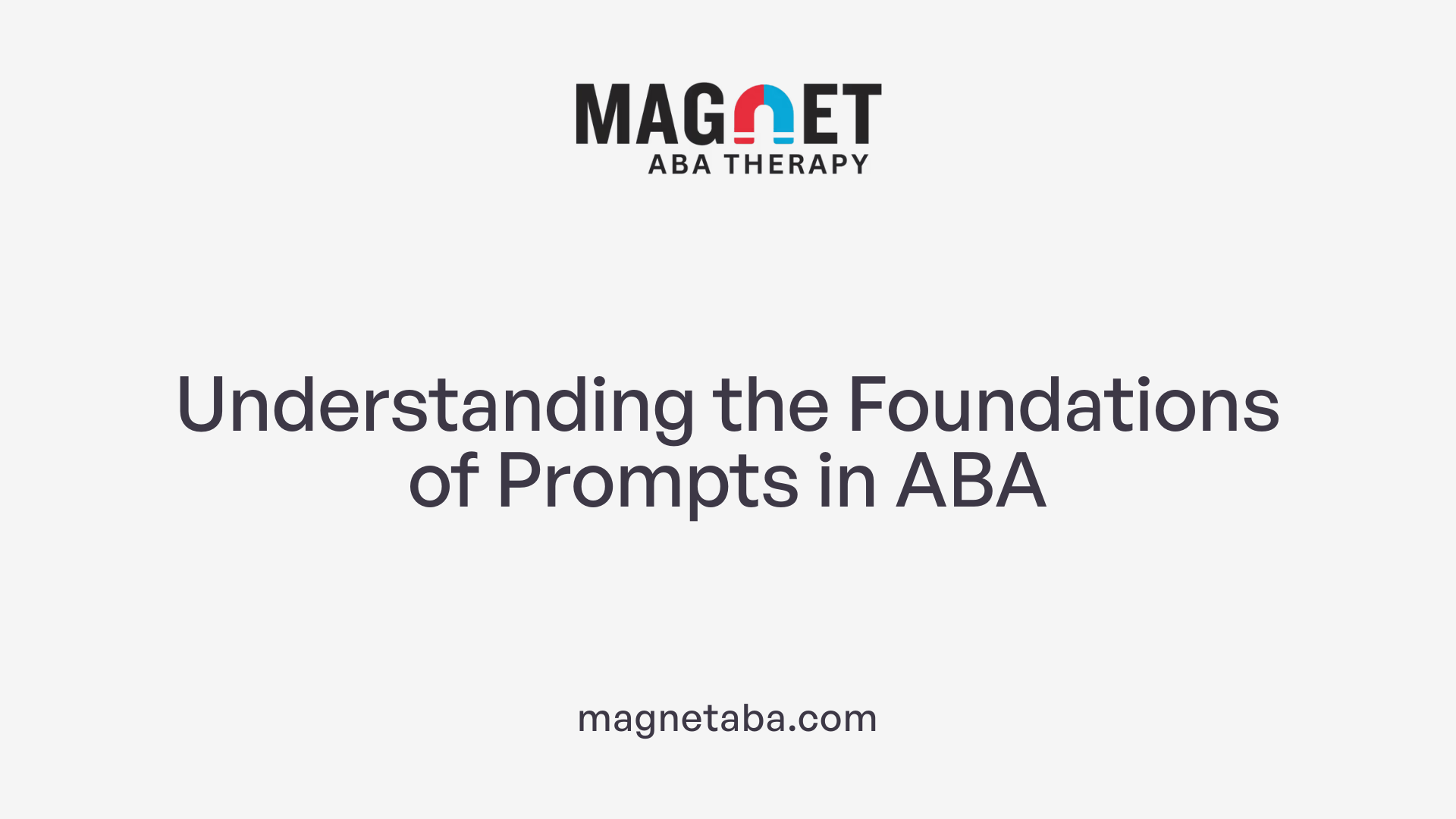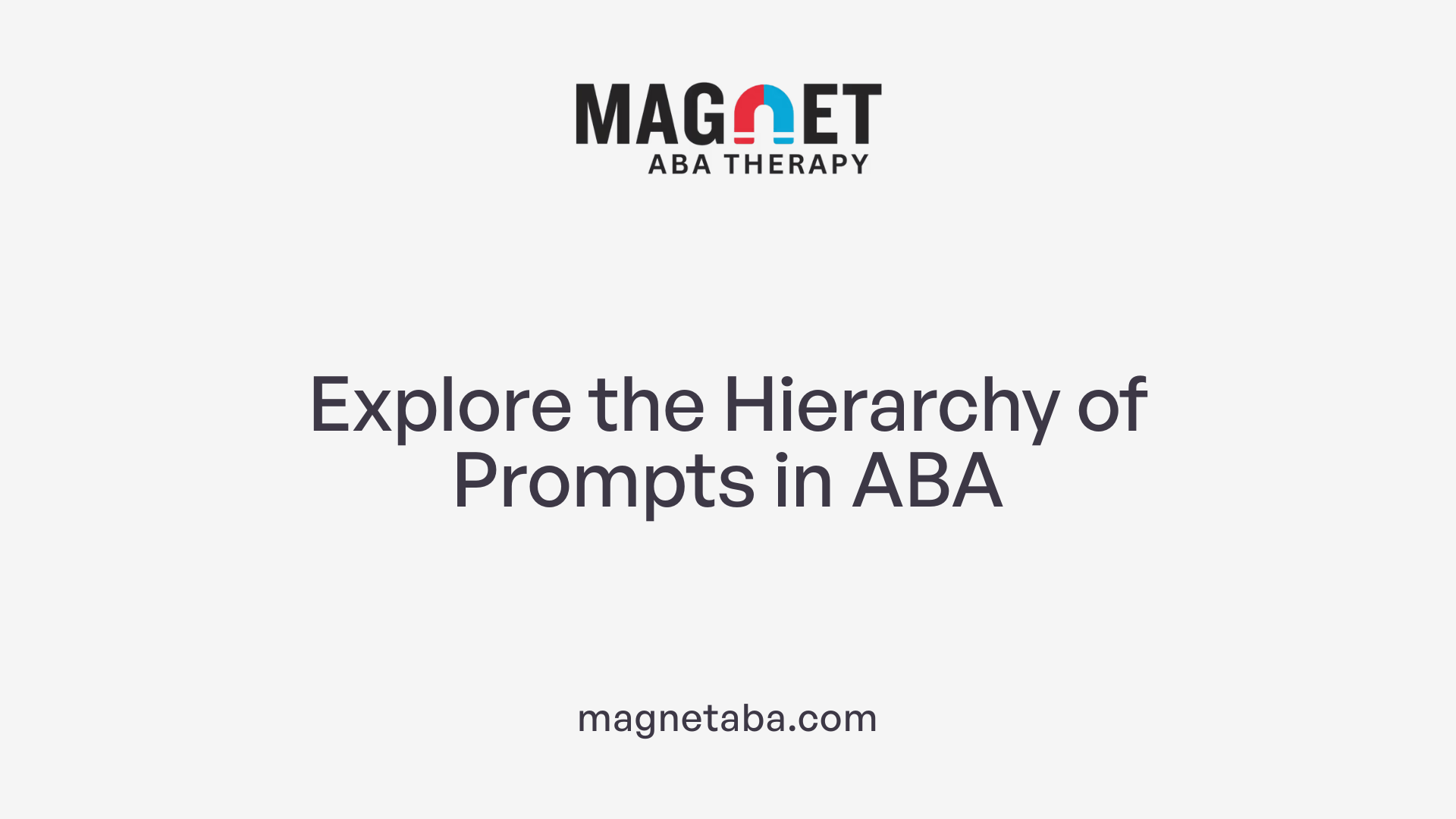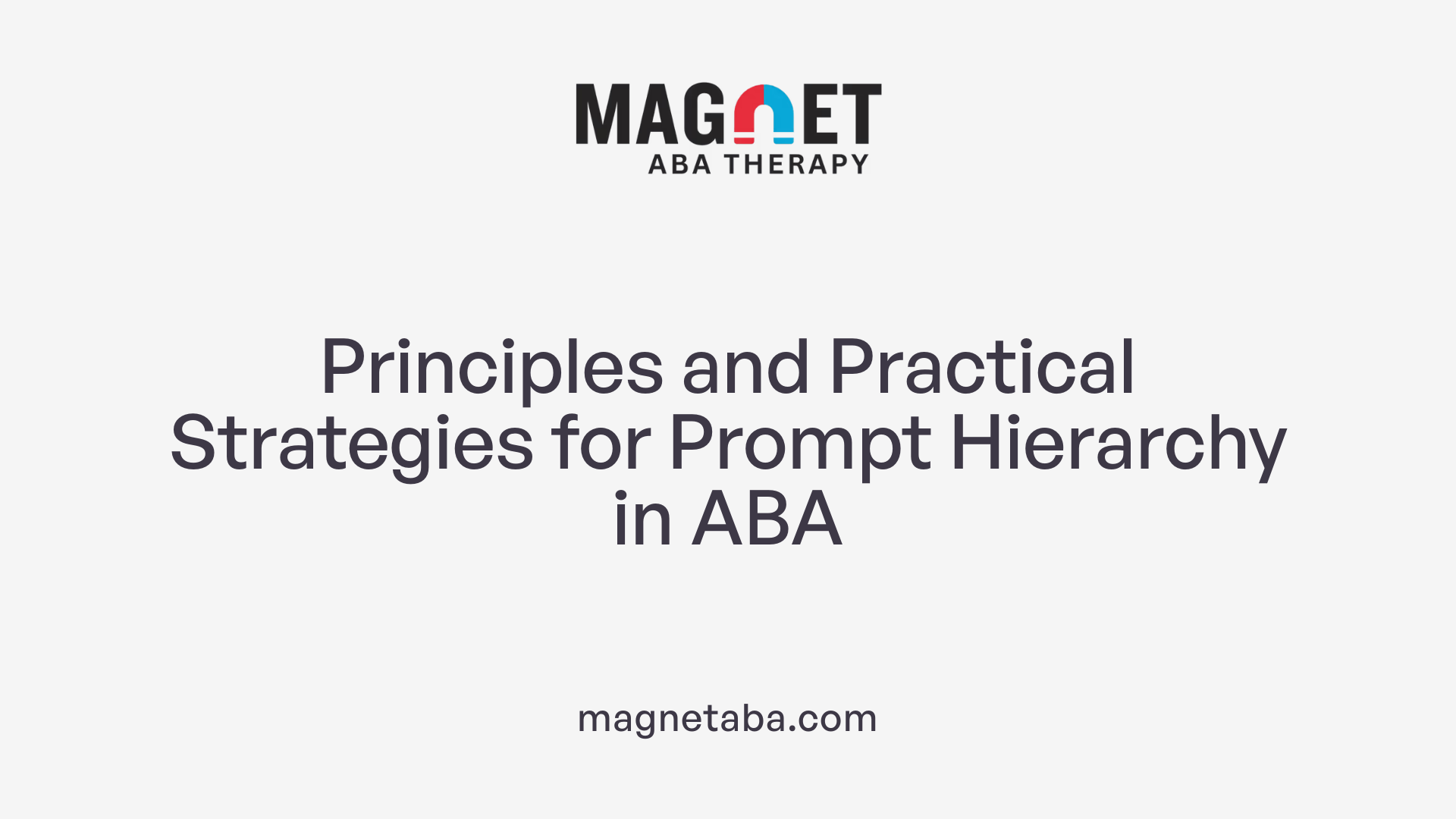Introduction to Prompt Hierarchy in ABA
The concept of prompt hierarchy is fundamental in Applied Behavior Analysis (ABA), serving as a structured framework that helps educators and therapists guide learners through acquiring new skills with minimal dependency on prompts. Understanding how prompts are systematically organized, selected, and faded is crucial for fostering independence and ensuring effective learning outcomes.
What is the Concept of Prompt Hierarchy in ABA?
Definition of prompt hierarchy
The prompt hierarchy in Applied Behavior Analysis (ABA) is a structured sequence of cues designed to help learners acquire new skills effectively. It begins with the most intrusive prompts, such as full physical guidance, and gradually moves toward less intrusive prompts like visual cues or independent performance. This systematic approach ensures that learners are supported appropriately at each stage of skill development.
The hierarchy includes various types of prompts, such as physical, verbal, model, gestural, and visual prompts. These prompts serve as signaling tools to guide learners toward correct responses and facilitate learning within a supportive framework.
Purpose of prompt hierarchy
The primary purpose of using a prompt hierarchy is to provide structured support that promotes skill acquisition while encouraging independence. By starting with more intrusive prompts and gradually decreasing support, practitioners can help learners build confidence and competence in performing new tasks.
Prompt hierarchies help prevent prompt dependence, where a learner relies too heavily on prompts, which can hinder the development of autonomous skills. They also provide a clear pathway for fading prompts systematically, ensuring that learning is retained and generalized across different environments and contexts.
Goals of using prompt hierarchy
The main goals of utilizing a prompt hierarchy in ABA include:
- Facilitating efficient skill acquisition by offering appropriate support at each learning stage.
- Promoting the development of independent behavior by gradually fading prompts.
- Ensuring learners can perform skills with minimal assistance over time.
- Enhancing overall motivation and reducing frustration by making tasks manageable.
- Supporting individualized instruction tailored to each learner’s needs.
Effective implementation of prompt hierarchies involves selecting suitable types of prompts, providing reinforcement, monitoring progress continuously, and adjusting the prompts as needed to optimize learning outcomes.
Strategies within the prompt hierarchy
Common strategies include:
- Least-to-most prompting: Starting with minimal support and adding support only if the learner does not respond.
- Most-to-least prompting: Beginning with maximum support and gradually reducing assistance.
- Time delay: Pausing for a specified time before providing a prompt.
- Partial physical prompts: Guiding only a part of the movement.
- Full physical prompts: Hand-over-hand assistance.
Implementing these strategies systematically fosters independence and ensures that learners can respond correctly with decreasing levels of assistance.
| Type of Prompt | Description | Example | Use in Hierarchy | |-------------------|-------------------------------------------------------------|--------------------------------------------------|-------------------------------------------| | Physical Prompt | Direct physical guidance; involves touch or hand-over-hand support | Guiding a child's hand to hold a spoon | Usually the most supportive in the hierarchy | | Model Prompt | Demonstrating the behavior for the learner | Showing how to tie shoelaces | Used early to cue correct performance | | Verbal Prompt | Spoken cues; full or partial | Saying |
What Are Prompts and Their Levels in ABA?

What are prompts and what are their different levels in ABA?
Prompts in Applied Behavior Analysis (ABA) are supplemental cues or hints that help a learner respond correctly to a stimulus, facilitating the acquisition of new skills. These prompts serve as additional guidance when the learner is initially unable to perform a task independently.
There are various types of prompts used in ABA, each tailored to specific scenarios and learner needs. Physical prompts involve guiding the learner physically, such as hand-over-hand assistance for performing a task. These are often categorized further into full physical prompts, where the instructor provides complete guidance, and partial physical prompts, where only part of the hand or body is assisted.
Verbal prompts involve spoken cues, which can be full prompts where instructions are demonstrated or explained, or partial prompts which include only a part of the verbal cue, such as a prompt phrase or a phoneme.
Visual prompts utilize visual cues to support learning. These include modeling the desired behavior, placing objects closer to cue the learner, gestural cues like pointing or mimicking actions, and other visual aids to guide responses.
The organization of prompts in ABA follows a hierarchy from most to least supportive. Initially, a prompt might involve physical guidance, but as the learner masters the skill, prompts are systematically faded to less intrusive forms. This organization allows for gradual independence, reducing reliance on prompts.
Two common prompting strategies are employed to structure this hierarchy:
- Least-to-Most Prompting: Starts with the least intrusive prompt (like a visual or gestural cue) and progressively introduces more support if the learner doesn't respond.
- Most-to-Least Prompting: Begins with the most intrusive prompt (full physical assistance) and gradually reduces support as the learner starts responding correctly.
Systematic fading of prompts is essential to promote true independence. The goal is for learners to perform tasks without prompts, demonstrating mastery. This process involves gradually reducing the assistance, making tasks more challenging until the learner can perform them wholly independently.
In summary, prompts are essential tools in ABA that, when organized properly from most to least intrusive and faded systematically, help learners acquire new skills effectively while fostering independence and confidence.
Types of Prompts and Their Hierarchical Organization in ABA

What are the different types of prompts used in ABA and how are they ordered in the hierarchy?
In Applied Behavior Analysis (ABA), prompts are supportive cues or hints provided to help learners respond correctly to instructional stimuli. These prompts are tailored to assist learners in acquiring new skills and fostering independence. The main types of prompts include physical prompts, verbal prompts, model prompts, gestural prompts, and visual prompts.
Physical prompts involve physical guidance or contact, such as hand-over-hand assistance, to physically lead a learner toward the correct response. Verbal prompts use spoken cues, which can range from full commands or instructions to partial verbal hints. Model prompts involve demonstrating the desired behavior, either fully or partially, to guide the learner visually. Gestural prompts are non-verbal cues like pointing or mimicking actions, such as pointing to a cup to indicate drinking. Visual prompts include cues like placing items closer to the learner or using visual aids to facilitate understanding.
These prompts are systematically organized in a hierarchy that progresses from the most intrusive to the least intrusive. Typically, the hierarchy begins with full physical prompts—where the instructor guides the learner's movements—then moves to partial physical prompts, model prompts, verbal prompts, gestural prompts, and finally visual prompts or natural cues that require minimal assistance.
The organization of prompts can follow either a most-to-least or least-to-most approach. In most-to-least prompting, the therapist starts with the most intrusive prompt and gradually reduces assistance as the learner gains mastery. Conversely, in least-to-most prompting, the intervention begins with minimal prompts, escalating only if necessary.
Effective implementation of prompt hierarchies involves immediate and contingent prompting following the instruction, accurate data collection to monitor progress, and systematic fading of prompts. Fading tips include gradually removing prompts over time to promote voluntary responses, thus preventing prompt dependency.
Overall, the strategic use of prompts in a hierarchical fashion supports errorless learning, increases the chances of success, and ultimately aims to promote learner independence across various environments and tasks.
Implementing the Prompt Hierarchy in Teaching and Learning
The prompt hierarchy is a structured approach used in ABA programs to assist learners in acquiring new skills efficiently while fostering independence. Its successful implementation involves careful selection of prompts, starting at an appropriate level of intrusiveness, systematically fading those prompts, and consistently monitoring progress.
How is the prompt hierarchy implemented in teaching and learning within ABA programs?
In ABA settings, the prompt hierarchy begins with choosing the most suitable prompts based on individual learner needs. Prompts are categorized by their level of intrusiveness, such as physical, modeling, verbal, gestural, and visual prompts. Educators typically start with the most supportive prompts—such as full physical guidance—and progressively move toward less intrusive prompts, like visual cues or independent responses.
The process can follow two main approaches:
- Most-to-Least prompting: Starting with the most intrusive support and reducing assistance as the learner responds correctly.
- Least-to-Most prompting: Beginning with minimal cues and increasing support only if needed.
The chosen approach depends on the learner's level of independence and the task complexity. Throughout instruction, prompts are systematically faded using strategies like time delay, gradual reduction of prompt assistance, or changing prompt intensity. This fading process encourages learners to respond more independently, reducing prompt reliance.
Monitoring learner progress is critical. Data collection and ongoing assessments inform whether prompts are effective, whether they need to be adjusted, or if the learner is ready for increased independence. Consistent documentation ensures that prompts are being faded appropriately, promoting skill mastery and generalization.
Selection of prompts based on learner needs
The selection process considers the learner’s current skill level and responsiveness. For example, a learner might initially benefit from full physical prompts, but as they become more proficient, partial physical or visual prompts might suffice.
Starting point: most intrusive or least intrusive prompts
Beginning with the most supportive prompts (most-to-least) or the least intrusive (least-to-most) depends on the individual’s needs, the task, and the context. Typically, learners who need more assistance start with more intrusive prompts to establish correct responses quickly. Over time, the prompts are faded to promote independence.
Gradual fading of prompts
Prompt fading is a deliberate process that gradually reduces assistance to encourage independent performance. Methods include:
- Time delay: Introducing a pause before providing a prompt.
- Graduated reduction: Decreasing the prompt's intensity or physical contact.
- Systematic removal: Transitioning from full physical prompts to visual cues or independent responses.
Fading should be individualized, paced according to learner readiness, and supported by data showing consistent improvement.
Monitoring progress and data collection
Effective implementation demands rigorous data collection on each prompting level and learner responses. Recorded data help determine when to enhance or reduce prompts, allow educators to assess skill generalization across settings, and ensure that progress aligns with goals.
In summary, the systematic application of the prompt hierarchy—starting with an appropriate level of support, using strategic fading practices, and maintaining diligent progress monitoring—supports successful skill acquisition. Properly executed, it promotes independence, reduces prompt dependence, and facilitates meaningful learning experiences tailored to each learner’s unique needs.
| Step in Implementation | Description | Techniques & Tools | Expected Outcomes |
|---|---|---|---|
| Prompt selection | Based on learner needs & task complexity | Physical, model, gesture, verbal, visual prompts | Appropriate initial support |
| Starting point | Most or least intrusive prompts | Full physical (most), visual (least) | Effective initial cueing |
| Systematic fading | Gradually reduce prompts | Time delay, graduated prompts, systematic removal | Increased independence |
| Monitoring | Continuous data collection & assessment | Graphs, checklists, observation notes | Timely adjustments, skill mastery |
The goal is to use a flexible, individualized approach that promotes independence while ensuring skill mastery and generalization across environments and contexts.
Prompt Fading Strategies and Their Practical Application
What are the different methods of prompt fading in ABA therapy?
Prompt fading involves gradually reducing the level of assistance that a learner receives during skill acquisition to promote independence. There are several approaches — each suited to different learning contexts and individual needs. The most common methods include most-to-least fading, least-to-most fading, and time delay strategies.
In the most-to-least fading approach, practitioners start with the most intrusive prompts, such as full physical guidance, and systematically decrease assistance as the learner gains competence. Conversely, the least-to-most method begins with minimal prompts, like visual cues, and then introduces additional support if needed. Time delay involves providing a prompt after a set period, allowing the learner an opportunity to respond independently before assistance is given.
Applying these methods effectively requires understanding the learner's current capabilities and carefully planning the progression of prompts to avoid frustration or prompts dependence.
How do practitioners implement prompt fading strategies in ABA therapy?
Practical implementation of prompt fading involves several systematic steps. First, practitioners identify the target skills or behaviors for mastery. Next, they select appropriate prompts—physical, verbal, gestural, or visual—based on the learner’s needs.
The process begins with establishing a prompt hierarchy that starts with the most supportive prompts and advances to less intrusive cues. During sessions, prompts are provided according to this hierarchy, with reinforcement given for correct responses. As the learner shows improvement, prompts are gradually faded by following a predetermined plan.
Consistency and continuous data collection are critical. Practitioners monitor the learner’s responses closely, documenting responses and adjusting the fading process as needed. This allows for tailored decision-making, ensuring prompts are faded at a pace that promotes mastery without overwhelming the learner.
Positive reinforcement—such as praise or tangible rewards—encourages successful independent responding. Over time, with systematic fades of prompts and ongoing assessment, learners transfer stimulus control from prompts to natural cues in their environment, promoting generalization.
Why is prompt fading important in ABA, and how does it promote independence?
Prompt fading is central to ABA because it directly influences a learner’s ability to perform skills independently. Excessive reliance on prompts can hinder natural learning processes, lead to prompt dependency, and limit generalization.
By systematically reducing prompts, therapists help learners develop confidence in their abilities and foster the transfer of skills to real-world settings. Fading prompts ensures that responses become more natural, reducing frustration and promoting motivation.
Ultimately, the goal of prompt fading is for learners to complete tasks with minimal or no assistance, demonstrating true mastery. It is a vital component in designing effective, individualized intervention plans that support long-term skill retention and independence.
What are some common prompt fading techniques used in practice?
Several techniques are employed to implement prompt fading effectively:
- Most-to-Least Fading: Begins with the most intrusive prompt and progressively reduces assistance.
- Least-to-Most Fading: Starts with the minimal cue, increasing prompts only if necessary.
- Time Delay: Introduces prompts after set intervals, giving the learner a chance to respond independently.
- Graduated Guidance: Using partial physical prompts and reducing physical contact gradually.
- Stimulus Fading: Slowly changing or removing visual or environmental cues.
Each technique offers benefits depending on the learner's needs and the complexity of the skill being taught. Combining methods can also enhance learning outcomes.
How do prompts like physical, verbal, gestural, and visual prompts fit into the fading process?
Prompts of different types serve as initial scaffolds for learner success and are faded systematically. Physical prompts involve guiding the learner’s movements, often starting with full hand-over-hand assistance and progressing to partial touches or cues.
Verbal prompts include spoken instructions or cues, which can be full (demonstration) or partial (hints or cues). These are faded by gradually reducing the complexity or clarity of the language.
Gestural prompts involve visual cues like pointing or mimicking gestures, which are shifted to less conspicuous cues or eliminated as the learner becomes more independent.
Visual prompts—such as picture cards or environmental placement—are used to guide responses and are reduced by spacing out cues or replacing them with natural environmental cues.
By systematically fading these prompts, practitioners support the learner in responding more independently while maintaining the learned skill.
What are some challenges and solutions in prompt fading?
Challenges include over-reliance on prompts, individual differences in learning pace, and difficulties in maintaining consistency.
To address these issues, practitioners should:
- Use varied prompting techniques to avoid prompt dependency.
- Regularly monitor progress and adjust the fading schedule accordingly.
- Provide training and supervision to ensure consistency.
- Incorporate natural environment cues to promote generalization.
Maintaining patience and flexibility during the fading process is essential, as each learner’s needs can vary significantly.
Table Summary of Prompt Fading Methods in ABA
| Method Type | Description | Common Prompts Used | Typical Fade Pattern |
|---|---|---|---|
| Most-to-Least | Starts with most intrusive prompt | Full physical, full verbal | Gradually replace with less intrusive cues |
| Least-to-Most | Starts with minimal prompts, increases if needed | Visual, gestural | Add prompts gradually if learner responds poorly |
| Time Delay | Use delay before providing prompts | Natural environmental cues | Increase delay intervals to promote independence |
| Graduated Guidance | Reduce physical assistance systematically | Partial physical prompts | Move from full guidance to minimal touch |
This systematic approach helps in individualizing learning and ensuring smooth transition toward independence.
Underlying Principles and Practical Application of Prompt Hierarchy

What are the principles behind the prompt hierarchy, and how are they practically applied in ABA therapy?
The prompt hierarchy in Applied Behavior Analysis (ABA) is built on the fundamental principle of systematically supporting learners to acquire new skills while gradually fostering independence. At its core, this hierarchy involves providing prompts that range from highly intrusive to minimally intrusive, ensuring each prompt effectively guides the learner toward the correct response.
Practically, ABA therapists start with the most supportive prompts, such as full physical guidance, and then move towards less intrusive cues like gestures or visual prompts. For example, during a learning task, a child might initially receive hand-over-hand physical prompts to complete a task. As they improve, the prompts are faded, moving through modeling, verbal prompts, and finally to just visual or positional cues, or even no prompts at all.
The process of fading is vital to preventing prompt dependence, which can hinder the learner’s ability to perform tasks independently. Strategies like most-to-least prompting involve beginning with maximal support and reducing it incrementally, whereas least-to-most prompting starts with minimal cues and increases support only if necessary. This flexible application allows therapists to tailor interventions to each learner’s needs.
A critical component of the hierarchy is ensuring prompts are delivered at the least intrusive level necessary to evoke the correct response. This minimizes frustration, enhances motivation, and promotes internalization of skills. Additionally, prompts are paired with reinforcement to strengthen successful responding.
Practitioners routinely identify target behaviors for intervention, select appropriate prompt levels, provide prompts systematically, and then fade these prompts based on the learner’s performance. Regular monitoring of progress is essential to adjust prompting strategies effectively.
In real-world applications, this systematic support enables learners to practice skills across various settings, helping to ensure that skills generalize beyond the initial teaching context. For example, a child who learns to request help at school can later transfer this skill to home or community environments.
Overall, the principles of the prompt hierarchy emphasize a thoughtful, individualized, and systematic approach, balancing guidance and independence. When applied correctly, they significantly enhance learning outcomes, increase independence, and facilitate the generalization of skills across different contexts and stimuli.
Addressing Challenges and Ensuring Generalization

What are the challenges faced when implementing prompt hierarchies, and how can they be addressed?
Implementing prompt hierarchies in Applied Behavior Analysis (ABA) can present several challenges that may affect the effectiveness of interventions. One common issue is over-reliance on prompts. When prompts are not systematically faded, learners can become prompt-dependent, which undermines the goal of promoting independence. To prevent this, practitioners need to follow a structured fading plan, gradually reducing prompts over time while continuously monitoring the learner's progress.
Another challenge involves individual differences among learners. Each learner has unique needs, learning styles, and responsiveness to prompts. Tailoring prompt types and levels to each individual is crucial. This customization ensures that prompts are neither too intrusive nor insufficient, which helps in maintaining motivation and engagement.
Consistency across different therapists or caregivers also poses a challenge. Variability in prompt levels or fading strategies can confuse learners and hinder skill acquisition. To address this, thorough training, ongoing supervision, and clear documentation are essential to maintain consistency.
Generalization of skills to new environments, settings, and with different people is vital for meaningful learning but can be difficult to achieve. Practitioners should incorporate varied training contexts, practicing skills in multiple environments and with different individuals. This broadens the learner’s ability to perform skills across various situations.
Ethical considerations are fundamental. Over-prompting or excessive assistance can diminish a learner’s dignity and hinder natural learning opportunities. Promoting independence requires a balance—using prompts only as necessary and always aiming to fade them appropriately.
To overcome these challenges, practitioners should employ a combination of strategies:
- Regular data collection to monitor progress and determine prompt effectiveness.
- Tailoring prompt levels based on individual responsiveness.
- Using a variety of prompting methods to prevent prompt dependence.
- Systematically fading prompts using established hierarchy principles.
- Providing consistent training and supervision to all involved in treatment.
- Respecting ethical standards by promoting autonomy and dignity.
Addressing these challenges effectively enhances the success of ABA interventions, ensuring learners develop lasting, functional skills that transfer across contexts. Continuously assessing and adjusting prompts, combined with ethical practice, helps in fostering true independence and meaningful learning outcomes for every individual.
Final Takeaways on Prompt Hierarchy in ABA
The prompt hierarchy in ABA is a cornerstone of effective teaching and learning strategies, enabling practitioners to systematically support skill acquisition while promoting independence. By understanding the different types of prompts, employing strategic fading techniques, and continuously monitoring progress, ABA therapists can optimize outcomes and foster lasting independence. As with any instructional framework, careful consideration of individual needs and ethical practices ensures that prompt hierarchies serve as empowering tools rather than crutches, guiding learners toward autonomous functioning across various environments.
References
- The Art of Prompting: A Guide to the Prompt Hierarchy in ABA
- Prompt Hierarchy in ABA: A New Perspective
- PROMPT HIERARCHY
- Prompt Hierarchy in ABA | Guided Learning and Growth
- ABA Prompting Hierarchies: Least-to-Most Prompting
- ABA Prompts: Types, Examples and Data Templates
- Prompt Hierarchy in Applied Behavior Analysis Therapy
- The Art of Prompting: A Guide to the Prompt Hierarchy in ABA
- Prompt Hierarchy in ABA: A New Perspective
- PROMPT HIERARCHY












